Nissan Laurel
The Nissan Laurel is a front-engine, rear-drive two- and four-door sedan manufactured and marketed by Nissan from 1969 to 2002. Introduced in 1968 as a new model positioned above the 1968 Datsun Bluebird 510, the Laurel offered the luxury of the Nissan Cedric 130 in a smaller size. The laurel is a noble tree in Greek mythology, and the laurel wreath a symbol of honorable status. In Japan, the Laurel was not marketed as a Datsun, being always labeled as a Nissan.
| Nissan Laurel | |
|---|---|
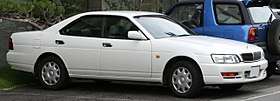 1998-99 Nissan Laurel | |
| Overview | |
| Manufacturer | Nissan |
| Production | 1968–2002 |
| Body and chassis | |
| Class | Mid-size car |
| Chronology | |
| Successor | Nissan Teana |
The first Laurel was developed by the Nissan Tsurumi R&D Division and assembled at the Musashimurayama Plant of the former Prince Motor Company in 2-door and 4-door variants. Released as a Nissan after Prince merged with Nissan, Laurels shared many components and architectures with the Skyline range. The Laurel was not marketed new in Japan at Nissan Prince Shop locations that sold the Skyline and Gloria, former Prince products. Instead the Laurel was sold at Nissan Motor Shop as the junior model to the larger V8-powered Nissan President.
Since 1968, eight generations of Laurel have been produced in Japan. Nissan intermittently listed the Laurel for sale in various Asian and European markets (it was also sold in Chile and Panama, as the Datsun Laurel, starting in the late seventies), and then discontinued the export of this model from 1989.
The Laurel was cancelled subsequent to Nissan's alliance with Renault.
First generation (C30) (1968–1972)
| Nissan Laurel C30 | |
|---|---|
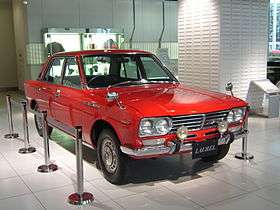 Nissan Laurel | |
| Overview | |
| Also called |
|
| Production | 1968–1972 |
| Assembly | Musashimurayama, Japan |
| Body and chassis | |
| Body style | |
| Layout | front engine/rear drive |
| Related | |
| Powertrain | |
| Engine | |
| Transmission | |
| Dimensions | |
| Wheelbase | 2,620 mm (103.1 in) |
| Length | 4,305 mm (169.5 in) |
| Width | 1,605 mm (63.2 in) |
| Height | 1,405 mm (55.3 in) |
| Curb weight | 1,005 kg (2,215.6 lb) |
In April 1968 Nissan presented its new Laurel in four-door deLuxe and Super deLuxe versions, both equipped with a 1.8 L inline-four engine and independent rear suspension. In June 1970 a two-door hardtop coupé joined the lineup, as a junior version of the all-new Nissan Cedric/Gloria coupe, and one year later a 2000 cc engine became available in the four-door sedan as well. Its competitors at introduction were the Toyota Corona Mark II sedan, and the Mazda Luce which was introduced in 1966. The Laurel did not sell as well as expected, largely because the design was too similar to that of the smaller, cheaper Bluebird (510).[2]
This car was developed by the Nissan Tsurumi vehicle development team, but the C30 Laurel was fitted with the Prince four-cylinder SOHC engine, the G18. (On the other hand, the GC10 Skyline 2000GT was developed by the former Prince Ogikubo vehicle development team, but was fitted with Nissan L20 six-cylinder SOHC engine.) This was of 1,815 cc capacity. The suspension is the same four-wheel independent system that was fitted on the C10 Skyline.
The Laurel Hardtop model was equipped with the SOHC 1,990 cc 110 or 120 PS (81 or 88 kW) G20-series four-cylinders. The four-door sedan was originally only available with the lesser G18. The SU twin-carburetted 2000GX received sporty equipment.
August 1970 saw the release of a modified version of the four-door sedan version, now with the same roof angle as that of the hard top. The instrument panel received redesigned panel meters, and the more luxurious GL grade was added.
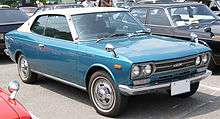
Second generation (C130) (1972–1977)
| Nissan Laurel C130 | |
|---|---|
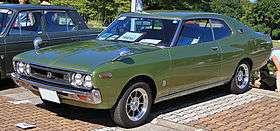 Nissan Laurel 2000SGX series C130 | |
| Overview | |
| Also called | Datsun Laurel Datsun 200L |
| Production | 1972–1977 |
| Assembly | Musashimurayama, Japan |
| Body and chassis | |
| Body style | 2-door hardtop coupé 4-door sedan |
| Layout | front engine/rear drive |
| Related | Nissan Skyline |
| Powertrain | |
| Engine | |
| Transmission | 4/5-speed manual 3-speed automatic |
| Dimensions | |
| Wheelbase | 2,670 mm (105.1 in) |
| Length | 4,500 mm (177.2 in) |
| Width | 1,670 mm (65.7 in) |
| Height | 1,415 mm (55.7 in) |
| Curb weight |
|
In April 1972 the second Laurel generation appeared, again in four-door saloon and two-door hardtop coupé form affectionately known as the Butaketsu Laurel ("pig's butt") because of its ample rear quarter panels and tail section, with the taillights incorporated into the rear bumper. The saloon now was endowed with a rear beam axle and leaf springs, while the coupé clung to independent rear suspension. In addition to the 1.8 and 2.0 L four-cylinder engines, a 2.0 L inline-six was now available, joined, from October, 1973, by a 2.6 L six; the latter was replaced by a 2.8 L six in late 1975. The G-20 4-cylinder and L20 six-cylinder engines were equipped with SU twin carburetors but were eliminated February 1976 due to emission regulations.
The styling of the coupe appears to be influenced by the 1970 Ford Torino and the 1971 Mercury Cougar, reflecting a popular styling trend during the 1960s and 1970s called "coke bottle". Sales in Japan (very few were exported) ran to about 96,000 per year, with three-quarters sedans.[3] The Toyota competitor was the Mark II coupé and sedan.
_in_Norway_B%2BW.jpg)
Engines available at the time were the four-cylinder 1815 cc G18 and 1990 cc G20, and the six-cylinder 1998 cc L20. Both the G20 and L20 were available with twin SU carburettors as an option. However, only the G20 equipped cars outwardly announced this with a "Twin Carburettor 2000GX" badge.
In October 1973 the first Laurel with the 2565 cc L26 six-cylinder engine was added and badged as "2600SGL". Since the engine was over two litres, it was not restrained by the size limits imposed by Japanese regulations, and therefore it was fitted with bigger bumpers than regular Laurels. The installation of the 2.6-litre engine in Japanese models helped identify this generation as a luxury car, as the larger engine obligated Japanese drivers to pay higher amounts of annual road tax.
In September 1975, in order to meet the new emissions regulations for that year, the L26 was replaced by the larger yet 2753 cc L28 six-cylinder. By October the carburettors in the L20 were replaced with electronic fuel injection and the engine was now dubbed L20E. Because of the difficulty in meeting the emissions regulations, the twin-carburetted engines were all discontinued. The 1,770 cc L18 replaced the G18 in the lineup.
In February 1976 carburetted 1.8-litre and 2.0-litre engines which met the 1976 emissions regulations were introduced, and were identified with the Nissan NAPS badge.

Laurel C130-EV
In 1974 Nissan developed an electric passenger sedan based on the Nissan Laurel. The Nissan Laurel C130-EV - referred to as the Datsun 200L-EV in export markets - developed to be used by the VIPs at the 1975 International Oceanographic Exposition in Okinawa.[4] It was originally engineered by the Prince Motor Company, but produced by Nissan when the company assumed Prince operations in 1966.
The C130-EV uses one 16.0 kW (21.5 hp) electric motor, rear-mounted and driving the rear axle through a two-speed automatic transmission. The Nissan Laurel C130-EV has a claimed top speed of 85 km/h (53 mph)[4] and a range of 65 km (40 mi). Nissan's next electric car venture would be the 1998 Altra.
Third generation (C230) (1977–1980)
| Nissan Laurel C230 | |
|---|---|
Nissan Laurel 2800 SGL Hardtop | |
| Overview | |
| Also called | Datsun Laurel Datsun 180L/200L/240L/280L |
| Production | 1977–1980 |
| Assembly | Musashimurayama, Japan |
| Body and chassis | |
| Body style | 4-door sedan 4-door hardtop 2-door hardtop |
| Layout | front engine/rear drive |
| Related | Nissan Skyline |
| Powertrain | |
| Engine | |
| Transmission | 3/4/5-speed manual 3-speed automatic |
| Dimensions | |
| Wheelbase | 2,670 mm (105.1 in) |
| Length | 4,525 mm (178.1 in) |
| Width | 1,685 mm (66.3 in) |
| Height | 1,405 mm (55.3 in) |
| Curb weight | 1,235 kg (2,722.7 lb) |
The third generation appeared in January 1977. For the first time, the C230 was available in either saloon and hardtop coupé form, but also as a hardtop saloon without B-posts. The hardtop was only available with six-cylinder engines. Buyers could choose between a 1.8-litre four, a 2.0-litre inline-six (carburetted or fuel-injected, a first for the Laurel), a 2.8-litre six, or a 2.0-litre diesel four, sourced from Nissan Diesel. Transmissions were mainly four- or five-speed manuals or a three-speed automatic, although a three-speed manual with a column shift was also available in the lower spec and commercial versions.[5] In the autumn of 1978 the C230 received a mild facelift (type C231), marked visually by squared instead of round double headlights. The Toyota competitor was the Mark II coupé and sedan. Again, comfort was prioritized over handling and agility.
.jpg)
One year later (January 1978) Nissan released a tenth anniversary edition, which adopted a special deep red body color known as "Laurel's Crimson", as well as trim-specific emblems, aluminum wheels and front grille. In 1979 the 2.4-litre L24 engine was added to the lineup.[5] European outputs were 71 and 83 kW (97 and 113 PS) DIN for the 2.0 and the 2.4 inline-sixes. European buyers were attracted to the Laurel for its overall reliability, low price, and ample equipment.[6] Datsun-Nissan South Africa also developed a two-litre four-cylinder option not offered elsewhere to suit local needs with a lower-cost, torquier engine than the two-litre six sold elsewhere. The L20B engine offered 72 kW (98 PS) and was paired with somewhat lower equipment than the 100 kW (136 PS) 280L sold alongside it.[7]
November 1978 brought minor changes to the Laurel, including squaring off of the front headlights. The highest trim level, "Medalist", received air conditioning in addition to its OHC four-cylinder two-litre diesel engine. The 1800 cc cars switched to the newer Z18 crossflow engine and all Laurels now met the Showa 53 (1979) gasoline vehicle emission regulations.
Later, in October 1979, a two-litre four-cylinder gasoline option (Z20-series) was added in several markets. Also new were the options of automatic transmission and the SGL equipment grade on diesel vehicles.

In February 1980 an electric sunroof was added to the hardtop version of the Medalist. This was the first year in which a sunroof was a model option.
In July 1980 a special limited edition "gold medalist" top-of-the-line trim was released.
Fourth generation (C31) (1980–1984)
| Nissan Laurel C31 | |
|---|---|
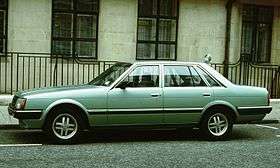 Nissan Laurel Sedan (C31, U.K.) | |
| Overview | |
| Also called | Datsun Laurel |
| Production | 1980–1984 |
| Assembly | Musashimurayama, Japan |
| Designer | Shinichiro Sakurai |
| Body and chassis | |
| Body style | 4-door hardtop 4-door sedan |
| Layout | front engine/rear drive |
| Related | Nissan Skyline Nissan Leopard F30 |
| Powertrain | |
| Engine | |
| Transmission | 4/5-speed manual 3/4-speed automatic |
| Dimensions | |
| Wheelbase | 2,670 mm (105.1 in) |
| Length | 4,635 mm (182.5 in) |
| Width | 1,690 mm (66.5 in) |
| Height | 1,360 mm (53.5 in) |
| Curb weight | 1,245 kg (2,744.8 lb) |
The C31 model, introduced in November 1980, was the first model that was only available in a four-door form, either as a sedan or hardtop. Engines for the C31 were 1.8-liter, 2.0-liter L20, 2.4-liter L24 gasoline, and 2.8-liter diesel. The coupé was replaced by the new Nissan Leopard F30. The Toyota competitor was the Cresta hardtop and the Chaser sedan. November 1982 saw the introduction of the Limited "Givenchy Version" with Hubert de Givenchy doing the TV commercials in Japan, borrowing a marketing concept for an American luxury coupe, the Lincoln Continental Mark IV. In 1981, the Nissan Laurel Spirit was offered as a smaller alternative to the Laurel, while still offering the luxury content of the larger car.
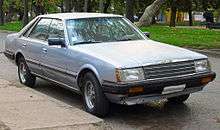
Development Supervisor, Itirou Makoto Sakurai, was in charge of developing the Laurel together with the Skyline. The Laurel's redesign was carried out in a European style and tone. The coefficient of drag (Cd value) of the four-door hardtop is 0.38. The lowest-priced Z18 is a four-cylinder engine, as is the 2-litre Z20. The L20-series are inline-six cylinder models, also available in fuel injected L20E type, and as the turbocharged L20ET - the first turbocharged Laurel. On top of the lineup was the 2.8-litre L28E, and for some export markets the 2.4-litre L24 engine (usually carburetted) was also offered. Mostly for commercial use there was the four-cylinder LD20 diesel engine, while private users usually preferred the larger six-cylinder LD28 type which was also available with much better equipment.
In February 1981 the GX trim level was added. L20E sedan with independent rear suspension in the vehicle suspension formula (a six-link independent rear suspension was equipped as standard on the turbocharged cars). In November 1981 the car received some improvement and the Turbo Medalist model was new to the lineup.
In September 1982 there was a minor change. Up a sense of luxury and large-scale extrusion in the chrome bumpers and rear license plate holder. The tail lamp design was changed as well. Instead of the Z18 series engine, the new OHC four-cylinder 1809 cc CA18S engine was fitted to the Laurel 1.8. The engine range was overhauled at the time and now included the CA18S, L20E, turbocharged L20ET, the four-cylinder SOHC Z20S, and the diesel LD20 and LD28-6 models. The carburetted L20, the L28E, and the column-shifted LD20 (six-seater) were discontinued. The six-cylinder gasoline-powered car with automatic transmission and Super Touring equipment received an overdrive gear at the same time.
In November 1982 the Givenchy limited version was released. In February 1983 the "50 Special" released. In March the Givenchy II version went on sale. In May another 50 Special II vehicles were launched. In July electrically retractable fender and door mirrors were introduced, a first. In October, taxi and driver instruction vehicles with an OHC LPG four-cylinder engine (Z18P, Standard or GL equipment) were added. SGL Grand Touring car (with a hubcap for Medalist colored bumper and large) and 50 Special Release III.
January 1984 saw the abolition of the 1.8-litre GL models, while the Givenchy III limited edition also went on sale.
.jpg)
European export models received the carburetted 2.0 (DX or SGL trim) and 2.4 inline-sixes (SGL), with 71 kW (97 PS) and 88 kW (120 PS) respectively, or with the large 2.8 diesel with 60 kW (82 PS).[8][9] A fuel injected 2.4 with 127 PS (93 kW) later appeared for some markets.[10] The 2.4-liter six only developed 113 PS (83 kW) in Swedish-market petrol cars as a result of that country's stringent emissions standards.[11] As large Japanese cars are not very popular with private buyers in Europe, the diesel saw the lion's share of sales, mainly for taxi usage. Fitted with a detuned version of the L24 engine, the Laurel was introduced to the Middle Eastern (mainly Saudi) market in 1982.
Fifth generation (C32) (1984–1989)
| Nissan Laurel C32 | |
|---|---|
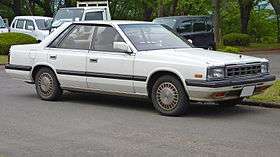 | |
| Overview | |
| Production | 1984–1989 |
| Assembly | Musashimurayama, Japan |
| Designer | Naganori Ito |
| Body and chassis | |
| Body style | 4-door hardtop 4-door sedan |
| Layout | front engine/rear drive |
| Related | Nissan Skyline Nissan Leopard F31 Nissan Pintara |
| Powertrain | |
| Engine | 1.8 L CA18S I4 2.0 L CA20S I4 2.0 L RB20E I6 2.0 L RB20DET turbo I6 2.0 L VG20ET turbo V6 2.4 L L24E 3.0 L VG30S V6 3.0 L VG30E V6 2.8 L LD28 diesel I6 2.8 L RD28 diesel I6 |
| Transmission | 5-speed manual 4-speed automatic |
| Dimensions | |
| Wheelbase | 2,670 mm (105.1 in) |
| Length | 4,650 mm (183.1 in) |
| Width | 1,690 mm (66.5 in) |
| Height | 1,425 mm (56.1 in) |
| Curb weight | 1,380 kg (3,042.4 lb) |
| Chronology | |
| Successor | Nissan Crew (taxi versions) Nissan Maxima (Europe) |
The C32 were fitted with four gasoline engines. The CA20S (which were the only four-cylinder to be seen in the C32), the L24S the VG20ET, the VG30E and the electronic carburettor installed VG30S. It also came with the LD28 diesel. In 1987 there were a minor facelift which basically were bigger bumpers, new grilles, and new lights in the front and back. The LD28 diesel engine were swapped out in favor of the similarly dimensioned RD28. This generation became the first Laurel with a V6 engine.
The C32 was the last model to be sold outside Japan. In Europe the Laurel was replaced by the Nissan Maxima which was not available as a diesel and had a sportier, more luxurious air. The Laurel was often used as a taxi in Germany.
The styling of the Nissan Laurel began to resemble the larger Nissan Cedric and Nissan Gloria but on a slightly smaller platform, with reduced tax liability based on the vehicles dimensions. The Toyota competitor was the Cresta hardtop and the Chaser sedan, and in 1986 the Honda Vigor.
In October 1984 the C32-facelift was released. Osamu Ito, Development Supervisor of the R31/32 Skyline, was assigned to redesign the Laurel. He saw the car needed significant changes, and set about doing so. Some of the Laurel's new features included a 4-door sedan body, variations in the hardtop, an angular design (including a strong push), and the world's first electric retractable door mirrors.
The RB20E engine was equipped with six-cylinder series SOHC2.0L, VG20ET-SOHC2.0L V6 turbo, CA18S-series four-cylinder (LPG and specifications), LD28-series 6-cylinder diesel SOHC2.8L. The car's system also integrated a C32 steering rack and adopted a rack-and-pinion type.
In May 1985, the Grand Extra Limited edition was released. Detail improvements were made in October 1985 and January 1986.
In October 1986 there were mechanical changes along with significant modifications to the exterior. There was a new turbocharged DOHC engine, the 2.0-liter RB20DET 24-valve six-cylinder, while the LD28 diesel engine was replaced by the new RD28-series six-cylinder diesel engine.
In May 1987 the "Grande Extra White Special" edition was release. In August of the same year, the Grande Touring Limited was added to lineup.
In February 1988 there was an improved and some 20 releases Super medalist anniversary special edition. In May 1988, the "White Limited" model was released. In September of the same year, the Super Series Selection was added to the lineup. In December private car and driving school versions were discontinued, leaving only taxis and other commercial models. In January 1989 Laurels with an automatic gearbox received a shift lock.
The taxi/commercial versions of the fifth generation were finally discontinued in July 1993, when they were replaced by the Nissan Crew.

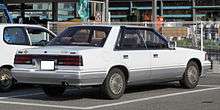
Sixth generation (C33) (1989–1993)
| Nissan Laurel C33 | |
|---|---|
| Overview | |
| Production | Japan: 1989–1993 |
| Assembly | Musashimurayama, Japan |
| Body and chassis | |
| Body style | 4-door hardtop |
| Layout | front engine/rear drive |
| Related | Nissan Skyline Nissan Cefiro Nissan Silvia S13 |
| Powertrain | |
| Engine | 1.8 L CA18i I4 2.0 L RB20DET turbo I6 2.0 L RB20DE I6 2.0 L RB20E I6 2.5 L I6 RB25DE 2.8 L I6 diesel RD28 |
| Transmission | 5-speed manual 4-speed automatic 5-speed automatic |
| Dimensions | |
| Wheelbase | 2,670 mm (105.1 in) |
| Length | 4,690 mm (184.6 in) |
| Width | 1,695 mm (66.7 in) |
| Height | 1,365 mm (53.7 in) |
| Curb weight | 1,330 kg (2,932.1 lb) |
In December 1988, the C33 Laurel was announced. A month later, in January 1989, the C33 went on sale, originally only available as a hardtop four-door. The base engine offering again was a 1.8-litre four, the available options consisted of a 2-litre six (SOHC, DOHC or DOHC Turbo) and a 2.8-litre diesel inline-six. Early in 1991 a DOHC 2.5-litre inline-six coupled to a five-speed automatic became available.

The Nissan Laurel used a rear-wheel drive layout, making it a popular car to modify for drifting use. The C33 in particular is very popular as a drift car, because it has the same floor plan as the Nissan A31 Cefiro and the four-door Nissan Skyline R32. They also have many interchangeable parts which makes them ideal for modification. Suspension parts are identical to the Nissan Silvia S13 model.
The Toyota competitor was the Cresta, and there was also the new Honda Inspire in the same segment. The Laurel was repositioned slightly higher as a larger luxury sedan, as its exterior dimensions matched with the Nissan Cedric and Nissan Gloria which were exclusive to separate Japanese Nissan dealerships (Nissan Bluebird for the Cedric, Nissan Prince for the Gloria). The Laurel still remained the junior sedan to the Nissan flagship Nissan President which was all new in 1989, and remained exclusive to Japanese dealership Nissan Motor Store locations.
Trim levels included the Medalist, Medalist Club S and Gran Limited. The Club S was the only C33 laurel with the RB25DE option and a front lip spoiler, with other models offering only the RB20, CA18 and RD28 engines.
V6 engines were no longer available; instead, the RB20E type (SOHC), RB20DE type (DOHC), RB20DET type (single turbo DOHC) series 6-cylinder 2.0L, CA18i series four-cylinder SOHC1.8L and RD28-series six-cylinder diesel engines were offered. In addition to this, the improved HICAS-II suspension configuration was used. Four-cylinder model (CA18i) series and six-cylinder diesel engine (RD28) in the presence and instruction car specifications.
On January 1991, the Laurel was facelifted and a new RB20E/RB20DE-powered 5-speed AT model crept into the range. Also in November 1991, 3-series cars RB25DE Catalogue DOHC2.5L add a grade-six-cylinder engine. 2.5L existing and additional models equipped with previous generations high mount side lamp, side door airbags. Organizing models in the senior grades.
In the North American market, this was only sold in parts of the Caribbean, primarily the Bahamas under the Nissan Laurel Altima. However, the Altima name was first used in the United States & Canada starting in the 1993 model year for its new compact car, which has since become a mid-size in 2002.
By January 1992 cumulative production achieved 2 million units.
Seventh generation (C34) (1993–1997)
| Nissan Laurel C34 | |
|---|---|
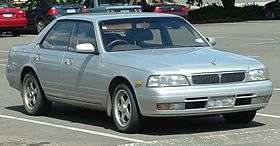 | |
| Overview | |
| Production | 1993-1997 |
| Assembly | Musashimurayama, Japan |
| Body and chassis | |
| Body style | 4-door hardtop |
| Layout | Front engine, rear-wheel drive / four-wheel drive |
| Related | Nissan Skyline Nissan Stagea Nissan Silvia S14 |
| Powertrain | |
| Engine | 2.0 L I6 RB20E 2.0 L I6 RB20DE 2.5 L Turbo I6 RB25DET 2.5 L I6 RB25DE 2.8 L Diesel I6 RD28 |
| Transmission | 5-speed manual(Diesel) 4-speed automatic 5-speed automatic |
| Dimensions | |
| Wheelbase | 2,720 mm (107.1 in) |
| Length | 4,710 mm (185.4 in) |
| Width | 1,720 mm (67.7 in) |
| Height | 1,390 mm (54.7 in) |
| Curb weight | 1,490 kg (3,284.9 lb) |
The Laurel C34 was no longer available in hardtop sedan configuration; the single body style offered was the regular saloon with B-posts. Gone as well was the four-cylinder engine. Available engines included a 2.0 L six (SOHC or DOHC), a 2.5 L DOHC six and a 2.8 L diesel six.
Some of the later models featured more sophistication such as Nissan's proprietary 4-wheel steering (HICAS) and 4-wheel drive (ATTESA) systems, which were based on the Skyline models. The Toyota competitor was the Cresta and the Honda Inspire. This was the first series that was no longer regarded as a compact sedan under Japanese vehicle classification regulations due to the engine displacement exceeding 2000 cc, and vehicle length and width were no longer in compliance. Japanese owners were now liable for additional taxes paid yearly in addition to standard registration, road tax, and inspection costs.
January 1993 the C34-facelift released. Catalog and全車3, body shape, with a view to ensure safety during side impact, plus a center pillar and HARDTOP 4. The smaller Laurel Spirit was replaced by the all-new Nissan Presea. ASCD (auto speed control), V G medalist steering switches that are only a selection of equipment. S club has electrical SUPERHICAS, ABS has been provided by the fitted. The RB20E engine-mounted, RB20DE type, RB25DE and RD28-type. 4-cylinder 1800 cc was abolished. Custom services LSD, REARMAINCHANGESUSPENSION, SUPER HICAS electric technology, diesel-RD28 for three-valve head (18 valves total) were used. Mission 5-speed MT only remaining medalist diesel and gasoline vehicles abolished MT car. System medalist, 20E Super Club Russell S is the ground sheet, ground tricot premium cruise medalist J, S Club is the gray Ecsaine. Medalist V, S Club are optional leather manufacturers (gray) Choose.
In May 1993 RB20E Club to add the S-type, 2.5 facelift car club and was only a 2-liter S version HAKATTA to boost sales by adding a liter.
In July 1993 and August 1993 Nissan was founded 60 years of additional special anniversary car. It was equipped with a key 60-year Anniversary.
January 1994 saw the major changes in the medium term. System has been added Fisher medalist in the center grille, front grille of the S Club new shape sporty type, S Club and dedicated to employing the front bumper, some design changes around the front. Club-S system RB25DET series 6-cylinder vehicle DOUBLETURBOENGINE add DOHC2.5L 24. Along with this series RB20DE abolished DOHC2.0L 24-6-cylinder car engine valves.
The September 1994 saw the latter type in MAJORCHANGE, Laurel's first medalist of Turbo AWD vehicles and additional vehicles. The minor change to the late-C34 has been changed significantly from the initially unpopular exterior design of the type.
Eighth generation (C35) (1997–2002)
| Nissan Laurel C35 | |
|---|---|
 | |
| Overview | |
| Production | 1997–2002 |
| Assembly | Musashimurayama, Japan |
| Body and chassis | |
| Body style | 4-door hardtop |
| Layout | Front engine, rear-wheel drive / four-wheel drive |
| Related | Nissan Skyline Nissan Stagea Nissan Silvia S15 |
| Powertrain | |
| Engine | 2.0L I6 RB20DE 2.5L Turbo-I6 RB25DET 2.5L I6 RB25DE 2.8L Diesel I6 RD28E |
| Transmission | 4-speed automatic |
| Dimensions | |
| Wheelbase | 2,720 mm (107.1 in) |
| Length | 4,765 mm (187.6 in) |
| Width | 1,730 mm (68.1 in) |
| Height | 1,400 mm (55.1 in) |
| Curb weight | 1,440 kg (3,174.7 lb) |
| Chronology | |
| Successor | Nissan Teana |

The eighth and last generation debuted in June 1997. The number of available models was further reduced; the models had a DOHC two-liter engine, a 2.5 L six, or a 2.8 L diesel six. In late 2002 Laurel production was ended. The Toyota competitor was the Cresta and the Honda Inspire. This generation finally lost the manual transmission.
June 1997 The C35-facelift. With the RB20DE engine type, RB25DE type, RB25DET type (such as adopting a variable valve timing mechanism is the same type "NEO straight 6 so-called" change the RB series engines. Spec Turbo achieve 280 horsepower. RB All-DOHC24-valve), and RD28 (SOHC 18-valve, carried over from the C34) of the four models. AT 4-speed transmission only. Expression strut suspension is the front (AWD vehicles are multiple-link type) and a rear multi-link type.
September 1998 Add to that lean burn RB20DE engine model. S Club series 2.5-liter car with automatic transmission with manual mode "DUALMODE M-ATx" adopted.
January 1999 RB20DE and lean burn types.
August 1999 Minor change. Medalist of the series set to premiere with the exterior design changes. RD28 diesel engine has an electronically controlled fuel injection system to change from type-RD28E.
March 2001 Production stopped at the Murayama plant and transferred to the Tochigi plant.
May 2001 RD28-engine grade is abolished.
August 2002 End of the 34-year production run of the Laurel.
February 2003 The Laurel was replaced by the Nissan Teana.
See also
- Nissan Laurel Spirit
- Nissan Skyline - sister car
- Nissan Cefiro
- Nissan Teana - successor
- Toyota Mark II - competing model
- Nissan Note - the second-generation top version has reintroduced the "Medalist" badge
References
- 1968 Nissan Laurel C30, www.earlydatsun.com Archived 2015-02-08 at the Wayback Machine Retrieved on 15 February 2015
- "New Model: Nissan Laurel". Motor Magazine International. Tokyo, Japan. 2 (1): 8. January 1974.
- Motor Magazine International (January 1974), pp. 9-10
- Sacket, Sheldon R. (1979). The Complete Book of Electric Vehicles. Domus Books. p. 103. ISBN 978-0891960850.
- Braunschweig, Robert; Büschi, Hans-Ulrich, eds. (March 6, 1980). "Automobil Revue '80" (in German and French). 75. Berne, Switzerland: Hallwag, AG: 262. Cite journal requires
|journal=(help) - Rombauts, Walter (1979-09-29). "Komfortable, robuust en probleemloos" [Comfortable, robust, and trouble free]. Keesings Auto Magazine (in Dutch). Antwerp, Belgium. 2 (18): 8–10.
- Wright, Cedric, ed. (August 1978). "New model: Datsun 200L". CAR (South Africa). Vol. 22 no. 7. Ramsay, Son & Parker (Pty) ltd. p. 71.
- Nissan Gamma [Nissan range] (brochure) (in Dutch), Aartselaar, Belgium: N.V. Nissan Belgium S.A., 1984, p. 3
- Kurki-Suonio, Hannu (1985-03-19). "Autotieto 1985" [Car specifications 1985]. Tekniikan Maailma (in Finnish). Vol. 41 no. 5/85. Helsinki: TM-Julkaisu. p. Automaailma 34. ISSN 0355-4287.
- Mastrostefano, Raffaele, ed. (1985). Quattroruote: Tutte le Auto del Mondo 1985 (in Italian). Milano: Editoriale Domus S.p.A. p. 672. ISBN 88-7212-012-8.
- Sundfeldt, Björn (1982-04-21). "Komplett Paket" [Complete Package]. Teknikens Värld (in Swedish). Vol. 34 no. 9. Stockholm, Sweden: Specialtidningsförlaget AB. p. 62.
- Automobil Revue, catalogue editions 1969, 1973, 1975, 1979, 2001.
External links
- Nissan Heritage Collection
- Nissan Laurel Club, in Russian
| Wikimedia Commons has media related to Nissan Laurel. |